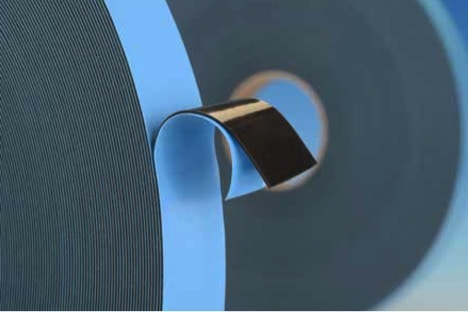
Release liners are that piece of paper or film that you remove to expose the adhesive on tapes or labels. Some people call it “the backing” but that is not exactly correct terminology.
Release liners are produced for the most part by applying very thin coatings of silicone release agent to one or both sides of various papers or films. (there are some non-silicone release liners but they are very specialized and will not be covered here)
Because the release liner is thrown away, not many give it a second thought-until it doesn’t come off or function as intended. The truth is that there is an entire release liner industry that is a critical ally to the manufacturers of tape and label materials and there’s a lot more going on than meets the eye.
The Basics- Carriers
First, let’s look at the types of carriers that are typically used to produce most release liners:
- Densified Kraft- a machine grade paper that has been run through a series of calendaring rolls to “smash down” the paper fibers into a sheet that has improved caliper control and ability to accept a silicone coating. These papers do not exhibit good dimensional stability in humid environments. They are often used in high speed rotary de-cutting operations.
- Clay Coated Kraft- papers that have added clays or fillers added to the paper to improve surface characteristics. These fillers reduce the amount of exposed paper fibers and the paper exhibits better dimensional stability.
- Polycoated Kraft- a paper that has a coating of polyolefin extruded onto one or both sides. The ‘poly” coating (often polyethylene) encapsulates the paper fibers except on the edges and greatly improves dimensional stability. These papers resist curling better than other kraft liners. The poly coating does compromise the heat stability of the sheet during the adhesive coating operation so care has to be taken when using them. Also, the hardness of the poly coating has to be considered when they are used for kiss cut part production.
- Polyethylene- a conformable film with excellent tear resistance that is available in a variety of thicknesses and densities. It has limited heat resistance during adhesive coating operations and silicone transfer can happen if the coating process is not properly designed. This liner (along with polypropylene) is often used on high performance bonding and assembly tapes since it exhibits excellent tear resistance and allows the liner to come off in one piece.
- Polypropylene- not as thermally sensitive as polyethylene, this liner too has exceptional tear resistance and good dimensional stability.
- Polyester- this film has superior caliper control and is often used in high speed kiss cutting and dispensing applications. Polyester liners are very popular for converted products in the medical and electronics industries.
The Basics- Silicone Chemistries
The two most common ways to think about silicone chemistry are in terms catalyst used and the energy system employed. The catalyst refers to the chemistry selected to “cure” the silicone coating (without proper cure, the silicone ends up contaminating the adhesive which is a not good!). The energy system refers to the type of equipment and process employed to achieve the cure.
- Thermally Reactive Systems- these silicones use tin or platinum as the catalyst to initiate silicone cure in the presence of heat. Tin is the oldest type of silicone curing catalyst. It is available in emulsion and solvent forms and cures very well with low potential for silicone transfer but the longer dwell times needed for cure limit the substrates or carriers that can be selected. Platinum catalyst systems cure faster than tin based systems and are available in emulsion, solvent, and 100% solids forms.
- UV Reactive Systems-these systems use a photo initiator in conjunction with a UV light source to cure the silicone release coating. The lower heat associated with this type of curing allows temperature sensitive materials such as polyethylene to be processed without excessive shrinkage.
- Electron Beam Systems- the least common type of system due to the expense of electron beam curing equipment, these high energy systems use the energy from the electron beam discharge to initiate the reaction to cure the silicone coating.
Adhesives and Silicones- Working Together
The tape or label stock manufacturer and the release liner supplier have to be natural allies. Not every liner will work with every adhesive. The adhesive chemistry has to be considered along with the coating process for the tape or label stock. downstream converting operations such a slitting, die cutting, kiss cutting, and laminating need to be understood along with how the product will be applied in the field.
For example, some rubber based adhesive don’t work well with UV cured liners and some high tack acrylic adhesives don’t like electron beam produced liners. Improper selection will result in a liner that is difficult to remove or doesn’t remove at all. An unhappy customer is the result!
If a densified kraft liner is selected for high speed kiss cutting and cost but will be applied via a dispensing system in an uncontrolled environment with high humidity, the applicator might jam and not perform properly.
Throw away items like release liners and product packaging often get little of our attention. We want to get to what’s inside the package or what’s behind the release liner.
The truth is that there is an incredible amount of science behind the selection of release liners and tape products. Tom Brown Inc. understands the importance of proper liner selection and can work with our customers to pick the right liner to meet your needs.
 Release liners are that piece of paper or film that you remove to expose the adhesive on tapes or labels. Some people call it “the backing” but that is not exactly correct terminology.
Release liners are produced for the most part by applying very thin coatings of silicone release agent to one or both sides of various papers or films. (there are some non-silicone release liners but they are very specialized and will not be covered here)
Because the release liner is thrown away, not many give it a second thought-until it doesn’t come off or function as intended. The truth is that there is an entire release liner industry that is a critical ally to the manufacturers of tape and label materials and there’s a lot more going on than meets the eye.
Release liners are that piece of paper or film that you remove to expose the adhesive on tapes or labels. Some people call it “the backing” but that is not exactly correct terminology.
Release liners are produced for the most part by applying very thin coatings of silicone release agent to one or both sides of various papers or films. (there are some non-silicone release liners but they are very specialized and will not be covered here)
Because the release liner is thrown away, not many give it a second thought-until it doesn’t come off or function as intended. The truth is that there is an entire release liner industry that is a critical ally to the manufacturers of tape and label materials and there’s a lot more going on than meets the eye.
